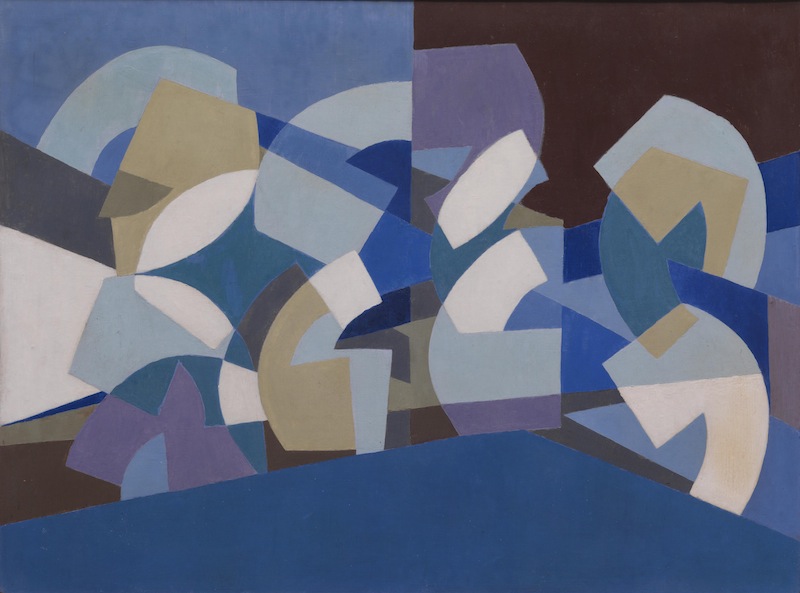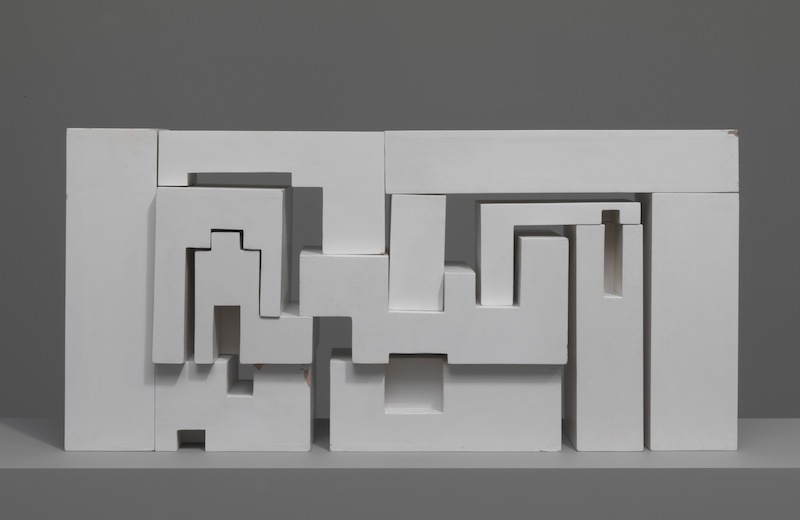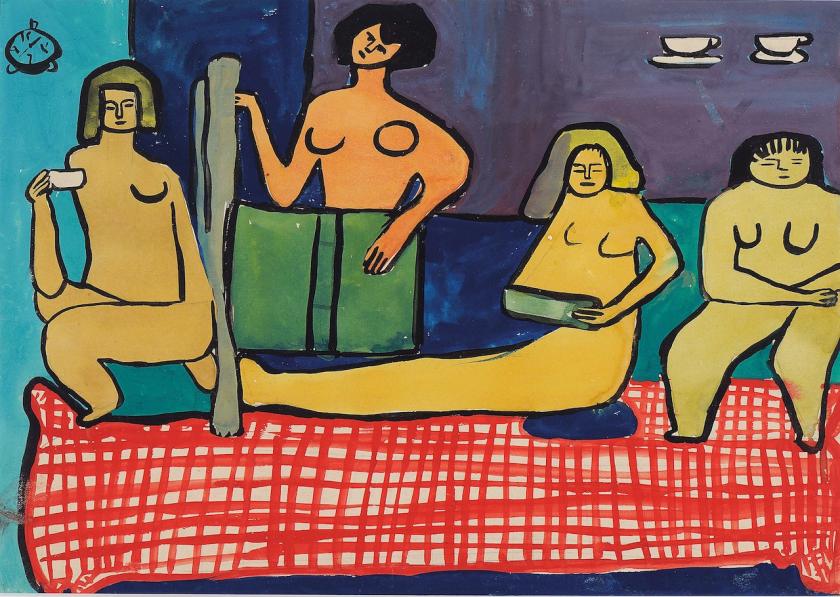Saloua Raouda Choucair began her career as a painter, initially studying under Lebanon’s two leading landscape artists, Mustafa Farroukh and Omar Onsi. In the late 1940s, she trained in the studio of Fernande Léger while studying at the Ecole des Beaux-Arts in Paris. Her exposure to art in her native Beirut would have given no hint of the vibrant modernism she would embrace, albeit several decades after Europe had been all aflush with the new. We see its late Middle-Eastern blossoming in the first room of this beautifully curated retrospective, which is, in fact, a world-premier for this 97-year-old artist.
Her modernist mask of pallid grey tones is enlivened with strips of yellow
We begin with an elegant, autumnally Fauvist self-portrait of 1943. Arresting almond eyes, their blackness emphasised with thick layers of kohl and dark angular eyesbrows, slide their gaze past us with cool insouciance. Her modernist mask of pallid grey tones is enlivened with strips of yellow that suggest her olive complexion. Colours don’t, in fact, veer too wildly from the descriptive.
Then we quickly skip to the late Forties and early Fifties and Léger’s influence, and that of Matisse, is evident. Her subjects are the monumental odalisque, painted on a small scale, on paper. She adopts a bolder palette and paints flat areas of colour and there’s the occasional art deco decorativeness, such as we see in the delightful Nude with Iris, 1948-9. In a series of paintings of the same period, Les Peintres Célèbres (main picture: Les Peintres Célèbres I), she’s taken Léger’s huge 1921 painting Three Women, with its three moon-faced machine-automaton nudes, and turned them into cruder cartoons. They still have their cups of tea and their books, but it’s a long way from Léger’s smooth, clean precision in which all life begins as a cube, a cone or a cylinder.
 Her figurative works give way to rhythmic abstract paintings featuring repeated motifs. (Pictured right: Composition in Blue, 1947-51). Shards and arcs of colour float or dance on seas of different colours, like late Bridget Rileys. But soon she eschews both colour and flat surface and turns to sculpture, with which she will make her most definitive statement as an artist. It is sculpture, carved from wood or stone, shaped from terracotta, or cast in bronze and brass and later constructed from steel, Plexiglass and string, for which Choucair must gain recognition. These are the works – finished pieces, maquettes and models for public projects that never came to fruition – that are the main focus of the exhibition.
Her figurative works give way to rhythmic abstract paintings featuring repeated motifs. (Pictured right: Composition in Blue, 1947-51). Shards and arcs of colour float or dance on seas of different colours, like late Bridget Rileys. But soon she eschews both colour and flat surface and turns to sculpture, with which she will make her most definitive statement as an artist. It is sculpture, carved from wood or stone, shaped from terracotta, or cast in bronze and brass and later constructed from steel, Plexiglass and string, for which Choucair must gain recognition. These are the works – finished pieces, maquettes and models for public projects that never came to fruition – that are the main focus of the exhibition.
 Here the abstract forms of western modernism meet the abstract forms of the Islamic tradition. Interlocking geometries, not perfect nor precise, produce something sensual, suggestive and rather playful. Poem Wall, 1963-5 (pictured left), carved from wood and painted white, is a jigsaw of geometric pieces. Voids are created from the loosely fitting pieces, and the sculpture’s provisional quality – it could all come tumbling down – suggest the modernist’s fascination with chance and the ephemeral, rather than the enduring and the eternal of Islamic art.
Here the abstract forms of western modernism meet the abstract forms of the Islamic tradition. Interlocking geometries, not perfect nor precise, produce something sensual, suggestive and rather playful. Poem Wall, 1963-5 (pictured left), carved from wood and painted white, is a jigsaw of geometric pieces. Voids are created from the loosely fitting pieces, and the sculpture’s provisional quality – it could all come tumbling down – suggest the modernist’s fascination with chance and the ephemeral, rather than the enduring and the eternal of Islamic art.
Duchamp naturally comes to mind when we get to Choucair’s hand-sized brass and aluminium sculptures. Part of an on-going series called Duals, these feature two interlocking pieces, one brass, the other aluminium. They’re a bit phallic and also a bit Yin and Yang. Meanwhile, Sculpture with One Thousand Pieces, 1966-8, suggest stacked crates or a towerblock. Here it’s the painstaking craftsmanship that stands out.
The final room is a revelation, so different from what has preceded it. It’s as if Choucair has lived many different lives as an artist. These buoyant string, steel and Plexiglass works from the Seventies and Eighties, in which pieces of glass are held in perpetual tension, shimmer and glow in the dimmed light.
Tate has organised this small but densely packed retrospective on its top floor and this is a good move. How often have their vast fourth-floor displays of even major artists simply felt too padded out? The size of this exhibition feels just right.









![SEX MONEY RACE RELIGION [2016] by Gilbert and George. Installation shot of Gilbert & George 21ST CENTURY PICTURES Hayward Gallery](/sites/default/files/styles/thumbnail_125_x_125_/public/mastimages/Gilbert%20%26%20George_%2021ST%20CENTURY%20PICTURES.%20SEX%20MONEY%20RACE%20RELIGION%20%5B2016%5D.%20Photo_%20Mark%20Blower.%20Courtesy%20of%20the%20Gilbert%20%26%20George%20and%20the%20Hayward%20Gallery._0.jpg?itok=3oW-Y84i)





Add comment